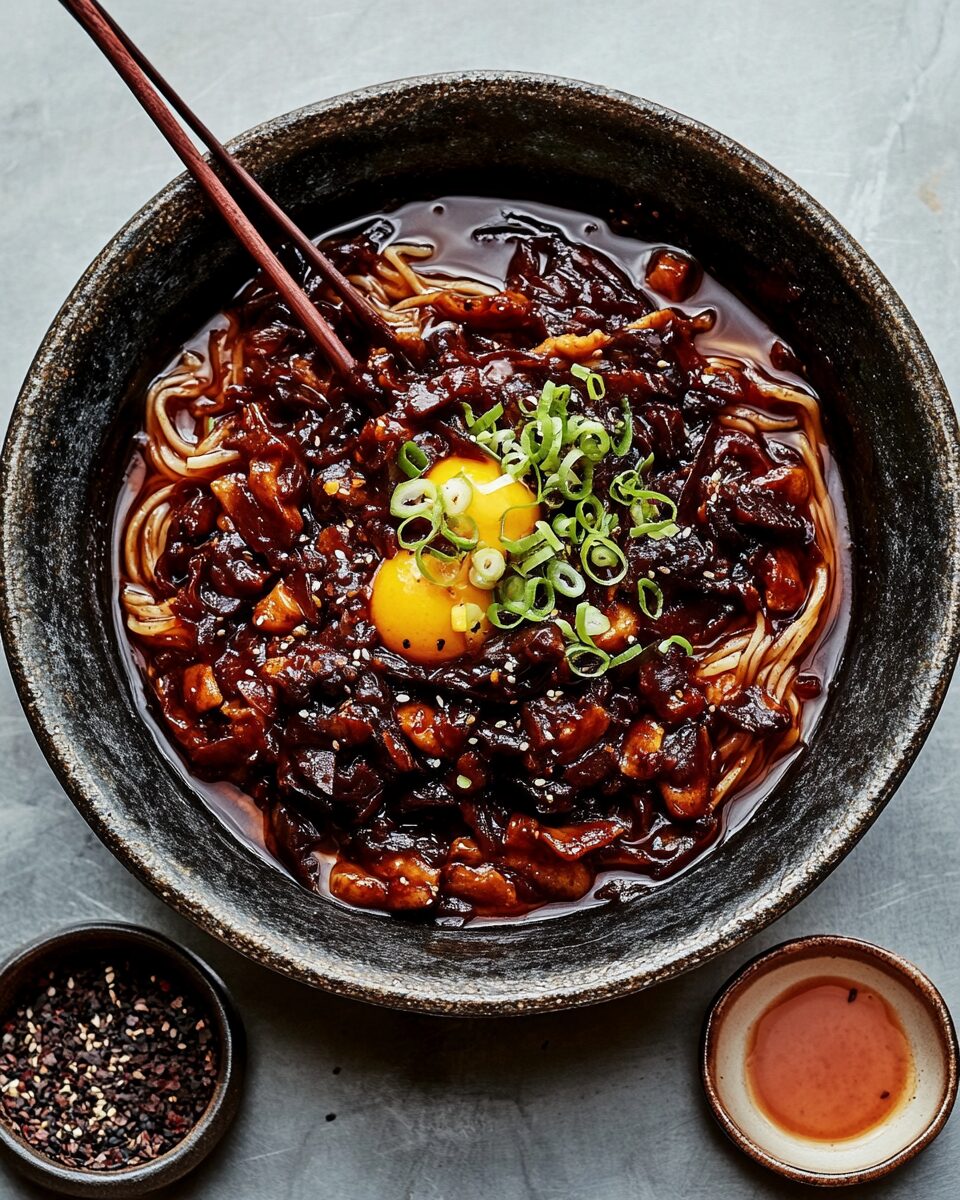Jajangmyeon is a beloved Korean noodle dish featuring a rich black bean sauce, diced pork, and vegetables. Originating from Chinese cuisine, it has become a staple in Korean dining culture, offering a comforting and flavorful meal.
FULL RECIPE:
Ingredients
- 2 cups fresh Jajangmyeon noodles or any thick noodles
- 200 grams diced pork belly or lean pork
- 3 tablespoons Chunjang (black bean paste)
- 1 large onion, diced
- 1 zucchini, diced
- 1 potato, peeled and diced
- 1/2 cup vegetable or chicken stock
- 2 tablespoons potato starch mixed with 3 tablespoons water
- 2 tablespoons sugar
- 2 tablespoons cooking oil
- 1 teaspoon minced garlic
- Salt and pepper to taste
- Chopped green onions for garnish
Directions
- Prepare the Ingredients: Dice the pork and vegetables into similar-sized pieces for even cooking.
- Cook the Pork and Vegetables: Heat oil in a large pan over medium heat. Add diced pork and cook until browned, about 5 minutes. Add onions, zucchini, and potatoes; cook until softened.
- Make the Black Bean Sauce: Reduce heat to low. Add Chunjang to the pork and vegetables, stirring to coat evenly. Pour in the stock, add sugar, salt, and pepper. Simmer until the sauce thickens.
- Cook the Noodles: While the sauce simmers, cook the noodles according to package instructions. Drain and rinse under cold water.
- Assemble the Dish: Place noodles in serving bowls, top with the black bean sauce, and garnish with chopped green onions.
Nutrition Facts
- Calories: 500 per serving
- Total Fat: 15g
- Saturated Fat: 5g
- Cholesterol: 50mg
- Sodium: 700mg
- Total Carbohydrates: 60g
- Dietary Fiber: 3g
- Sugars: 7g
- Protein: 15g
- Potassium: 600mg
- Calcium: 150mg
- Iron: 4mg
History and Cultural Significance of Jajangmyeon
Jajangmyeon is a quintessential Korean-Chinese dish with roots in the early 20th century. It originated from the Chinese cuisine known as Zhajiangmian, brought to Korea by Chinese immigrants in the port city of Incheon. Over time, it evolved to suit Korean tastes, with the addition of the distinct black bean paste called Chunjang. Today, Jajangmyeon is a widely cherished comfort food in South Korea, often enjoyed on special occasions such as “Black Day” by those who are single. This noodle dish carries cultural significance as a symbol of Korean-Chinese culinary fusion. Restaurants specializing in Jajangmyeon, commonly called “Junggukjip,” can be found across South Korea. It is also a popular delivery food, making it a go-to choice for quick and affordable meals. Despite its Chinese roots, the Korean adaptation has gained a unique identity, making it a staple in Korean cuisine.
Flavor Profile and Texture
Jajangmyeon is characterized by its rich and savory black bean sauce, which is slightly sweetened to balance the umami flavors. The sauce’s glossy, dark appearance comes from the fermented black bean paste, which imparts a deep earthy taste. Combined with tender pieces of pork and a medley of vegetables like onions, zucchini, and potatoes, the sauce becomes a hearty complement to the chewy noodles. The noodles are typically thick and bouncy, offering a satisfying bite. Each strand is coated in the luscious sauce, ensuring every mouthful is packed with bold flavors. The addition of chopped green onions as a garnish enhances the overall aroma, adding freshness to the dish.
Variations of Jajangmyeon
While the classic pork-based Jajangmyeon remains the most popular, several variations have emerged to cater to different dietary preferences and regional tastes. Some popular adaptations include: Seafood Jajangmyeon: Featuring shrimp, squid, and mussels, this version is a favorite among seafood lovers. The natural sweetness of the seafood complements the black bean sauce. Gan Jajangmyeon: A drier version of the dish with a thicker sauce, often served without the additional broth typically found in traditional Jajangmyeon. Vegetarian Jajangmyeon: Prepared using tofu, mushrooms, and an assortment of vegetables, this option is perfect for vegetarians seeking a plant-based alternative. Samseon Jajangmyeon: A luxurious variety that includes a mixture of premium seafood, offering a more decadent dining experience.
Health Benefits and Nutritional Aspects
Jajangmyeon provides a balanced combination of carbohydrates, protein, and vegetables, making it a filling meal. The black bean paste used in the sauce contains fermented soybeans, which are rich in antioxidants and beneficial probiotics that support gut health. The inclusion of vegetables like zucchini, onions, and potatoes adds fiber, vitamins, and minerals to the dish. However, it’s essential to note that Jajangmyeon can be relatively high in sodium and fat due to the pork belly and black bean paste. For a healthier twist, consider using leaner cuts of meat or incorporating more vegetables for added nutrients. Those looking to reduce calorie intake may also opt for a smaller portion or balance the meal with a side of pickled radish, which is commonly served alongside Jajangmyeon to cleanse the palate.
Pairing Suggestions
To enhance your Jajangmyeon experience, consider pairing it with traditional Korean side dishes. Popular accompaniments include: Danmuji (Pickled Radish): The tangy and slightly sweet flavor of pickled radish provides a refreshing contrast to the rich black bean sauce. Kimchi: Spicy and fermented, kimchi adds a punch of flavor that complements the savory noodles. Manduguk (Dumpling Soup): Serving Jajangmyeon with a light dumpling soup creates a comforting and well-rounded meal. A glass of Korean barley tea or a refreshing soda can also be a great beverage choice to cleanse the palate between bites.
Cooking Tips and Techniques
To achieve the authentic taste and texture of Jajangmyeon, follow these tips: Use Fresh Noodles: Fresh Jajangmyeon noodles provide a chewy texture that complements the thick sauce. If unavailable, thick wheat noodles can be used as a substitute. Properly Fry the Black Bean Paste: Frying the Chunjang paste in oil before adding other ingredients enhances its flavor and removes any bitterness. Balance the Sweetness: Adjust the sugar level based on personal preference. Some prefer a slightly sweeter sauce, while others enjoy a more savory profile. Thicken the Sauce: Using a potato starch slurry helps achieve the signature thick consistency of Jajangmyeon sauce.
Conclusion
Jajangmyeon is a beloved staple in Korean cuisine that exemplifies the harmonious blend of Chinese and Korean culinary traditions. Its bold black bean sauce, tender pork, and vibrant vegetables make it a satisfying comfort food enjoyed by people of all ages. Whether served on a casual family dinner night or during a special celebration, this dish offers a delightful dining experience. By exploring variations and adding personalized touches, home cooks can enjoy a taste of authentic Korean culture in their own kitchens. Embracing the art of making Jajangmyeon also means savoring the rich history and cultural significance that it represents. So next time you’re in the mood for a comforting noodle dish, consider preparing a steaming bowl of Jajangmyeon for a delicious and memorable meal.






